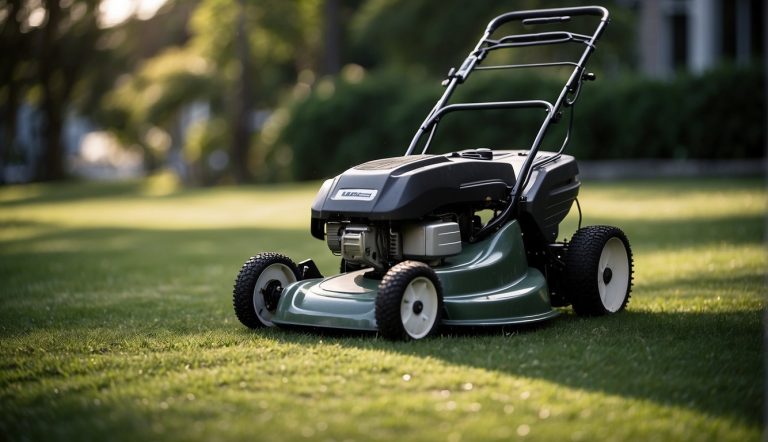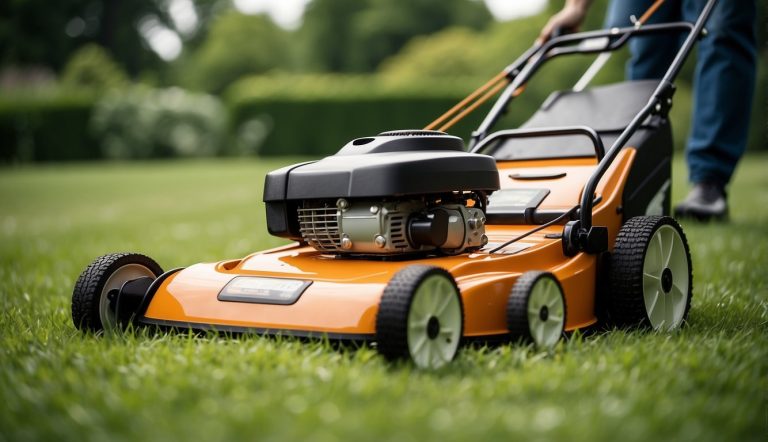Are Rotary Lawn Mowers Any Good? Unveiling the Pros and Cons
When it comes to lawn maintenance, choosing the right equipment can make all the difference.
Rotary lawn mowers, with their horizontally spinning blade, are a popular choice for many homeowners.
Unlike reel mowers which use a scissor-like cutting action, rotary mowers chop the grass with a sharp blade moving at high speeds. This method is well-suited for handling a variety of grass types and conditions, including tall and thick grass.

I find that rotary mowers offer a convenient and effective way for keeping lawns groomed.
They come in various models including electric and traditional gas-powered versions. The accessibility and user-friendliness of electric mowers have made them increasingly popular for those seeking a quieter and more environmentally friendly option.
As for traditional gas-powered mowers, they offer unmatched power, making them suitable for larger lawns or tougher conditions.
Maintenance is key for ensuring the longevity of a rotary mower, and by following some practical usage tips and troubleshooting advice, users can enjoy a consistently well-kept lawn.
Key Points…
- Rotary mowers are versatile and able to handle different grass types.
- Electric and traditional gas-powered mowers each offer distinct benefits.
- Proper maintenance is crucial for optimal performance and longevity.
Table of Contents
Understanding Rotary Lawn Mowers
When I think of lawn care, rotary lawn mowers come to mind as a common choice for their versatility and ease of use. Here’s a breakdown to help you grasp the basics of rotary lawn mowers.
Rotary Versus Reel Mowers
Reel Mowers: These feature a set of blades that spin vertically, best suited for cutting short and fine grass. They provide a precise cut by scissor-like snipping.
- Pros: Gentle on grass, precise cut, typically requires less power.
- Cons: Struggles with tall or thick grass, often manual, not ideal for rough terrain.
Rotary Mowers: Equipped with a horizontally spinning blade, they are adept at tackling long, dense, and uneven grass. The rotary blade’s high speed allows for effective cutting through tough vegetation.
- Pros: Versatile, handles challenging lawn conditions, widely available in electric, gas, and battery-powered models.
- Cons: Can be rougher on grass, may need frequent sharpening of rotary blades.
Components and Functionality
The heart of a rotary lawn mower is its rotary blades—a single or multiple blades that spin at high speeds, creating a cutting motion that chops the grass. These mowers typically have a safety housing to prevent debris from flying out. They may be push-type or self-propelled for ease of use.
Power Sources:
- Electric rotary mower: Quiet and environmentally friendly, often lighter than gas versions.
- Gas rotary mowers: Ideal for larger lawns due to continuous power, typically more powerful than electric mowers.
- Battery-powered mowers: Offer the convenience of cordless operation and are better for the environment compared to gas mowers.
Different Types of Rotary Mowers
Rotary mowers come in various styles to cater to different lawn care needs:
- Standard push mower: Ideal for small to medium yards, requires manual effort to move.
- Self-propelled mower: These mowers drive themselves forward, reducing the effort needed to mow. Some variants allow for speed adjustment to match the user’s walking pace.
- Hover mower: Utilizes a cushion of air to hover above the ground, making it easy to maneuver and ideal for irregularly shaped lawns or steep inclines.
Advantages and Disadvantages
In exploring rotary lawn mowers, I’ll focus on their effectiveness, ongoing maintenance, environmental impact, and overall value. Each aspect plays a crucial role in determining whether a rotary lawn mower is the best choice for your lawn maintenance needs.
Efficacy in Grass Cutting
Pros:
- Rotary mowers are excellent for managing tall and rough grass.
- They offer versatility, easily handling various grass types and conditions.
Cons:
- May not provide as clean a cut as reel mowers, which can affect grass health.
Maintenance and Durability
Pros:
- Typically require less maintenance than reel mowers.
- Known for their durability, standing up to tough mowing tasks.
Cons:
- Blades need regular sharpening to ensure optimal performance.
- Some models may have higher mower maintenance costs due to complexity.
Environmental Considerations
Pros:
- Modern models are available with eco-friendly electric options, reducing carbon emissions.
Cons:
- Gas-powered units contribute to noise pollution and emit exhaust fumes.
Cost and Value
Pros:
- Generally offer good value, with a range of prices to fit various budgets.
- The initial price is often balanced by the low maintenance costs, especially in less complex models.
Cons:
- Electric models, while eco-friendlier, might come with a higher upfront cost.
Practical Usage Tips

In my experience, keeping a lawn looking great all starts with using the right mower and mowing technique. Here’s how I make sure my yard stays manicured and safe for everyone, including kids.
Selecting the Right Mower for Your Lawn
When I choose a mower, I consider the size and topography of my lawn. For small to medium-sized lawns, a standard push rotary mower usually does a fine job. In contrast, lawns that span larger areas benefit from self-propelled or riding mowers.
- Lawn Size
- Small: Push mower
- Medium: Self-propelled mower
- Large: Riding mower
Adjusting the cutting height is crucial, especially when it’s the peak of the mowing season. I start higher at the beginning of the season and gradually lower the blades to avoid stressing the grass.
- Cutting Height Adjustment
- Early Season: Higher
- Mid-Season: Lower as needed
Optimizing Mowing Techniques
Mowing technique matters as much as choosing the right mower. I mow when the grass is dry to avoid uneven cuts and clumping.
I’ve found that sharp blades are a must for a crisp, even cut, eliminating jagged edges that can discolor tips of the grass.
- Mowing Tips
- Grass Condition: Dry
- Blade Sharpness: Keep blades sharp for smooth cuts
For tall grass, I mow more frequently with incremental height adjustment to prevent stressing the lawn.
Also, alternating mowing patterns keeps my lawn healthier and prevents rut formation.
- Dealing with Tall Grass
- Increase mowing frequency
- Adjust height gradually
Safety and Operational Advice
Before I mow, I ensure the mower is in good condition, which includes checking the oil and fuel levels.
I always clear the lawn of any objects that could become dangerous projectiles and make sure kids are at a safe distance.
- Pre-Mow Safety Checks
- Check oil and fuel
- Remove debris from the lawn
While mowing, I use ear protection and keep focused on the task to prevent accidents.
Mowing is an exercise in itself, so I stay hydrated and take breaks as needed.
- Mowing
- Wear ear protection
- Stay aware and take breaks for safety
Maintenance and Troubleshooting
In my experience, keeping your rotary mower in top shape isn’t just beneficial—it’s essential. Regular maintenance ensures clean cuts, less wear on the mower, and fewer issues in the long run. Let’s walk through what I believe are the most effective steps to keep your mower running smoothly.
Regular Maintenance Schedule
Weekly:
- Check the oil level to ensure it’s within the recommended range.
- Clean the mower to prevent debris build-up.
Monthly:
- Inspect rotating blades for wear and tear.
- Check for loose bolts and nuts.
Seasonally:
- Replace the oil to ensure the engine runs smoothly.
- Clean or replace the air filter to prevent overheating and power loss.
Yearly:
- Schedule a professional service to handle complex maintenance needs.
How to Sharpen or Replace Rotary Blades
Sharpening Blades:
- Disconnect the spark plug wire for safety.
- Remove the blades using a wrench, then use a file or sharpening stone, following the blade’s angle.
- Check for balance before reinstalling.
- Reattach the blades securely.
Replacing Blades:
- If sharpening isn’t enough due to deep nicks or thinning, purchase matching replacement blades.
- Follow the same removal steps as for sharpening, then attach the new blades snugly in place.
Common Issues and Solutions
Tearing Grass Rather Than Cutting:
- Likely a sign of dull blades. Sharpen or replace them.
Uneven Cuts:
- Ensure the tire pressure is even on all wheels.
- Check for bent blade or spindle and repair or replace.
Mower Vibrating Excessively:
- Check for debris caught in the blades or a loose blade.
Flying Debris:
- Always clear the lawn of stones and sticks before mowing.
- Inspect for any damage to the mower deck.
Engine Trouble:
- Regular oil changes and air filter checks can prevent many engine issues.
Disease or Fungi in Lawn:
- A well-maintained mower reduces the risk of spreading lawn diseases.
Accessorizing and Enhancements

When it comes to keeping my lawn pristine, accessorizing and enhancing my rotary mower is essential. It’s not just about what the mower comes with; it’s how I can customize it to my lawn’s specific needs.
Upgrading Your Rotary Mower
I always start with the basics by making sure the grass collection system is efficient. Some models, like the Bosch Rotak 34, come with a built-in grass box or bag that’s easy to detach and clear out.
For those looking for a greener option, a battery-powered mower can be a game-changer, reducing pollution and noise.
I find that the Fiskars manual lawn mower offers a perfect combination of eco-friendliness and physical exercise, while for larger lawns, a riding mower could be a worthwhile investment.
Storage and Cleaning Solutions
After a good mow, storing my mower correctly ensures it stays in top condition. I have a designated spot in my garage to keep it dry and shielded from the elements.
Cleaning is crucial, too; keeping blades free from clippings helps maintain a sharp cut for that sought-after striped lawn effect. Brands like Flymo often design mowers with easy-to-clean features for convenience.
Frequently Asked Questions
I’m here to guide you through some common inquiries about rotary lawn mowers. My aim is to provide clear, helpful information about their use, advantages, and aspects to consider.
What are the advantages of using a rotary lawn mower over other types?
Rotary lawn mowers are versatile and excel in cutting long, dense grass. Their high-speed horizontal blades make them ideal for less manicured lawns.
Can you highlight any disadvantages of using rotary mowers?
One downside is that they may not cut as close or as cleanly as cylinder models, potentially affecting lawn appearance. They also tend to be louder and could produce more emissions.
What should I consider when choosing between a cylinder and a rotary lawn mower for my yard?
My advice for choosing hinges on your lawn’s characteristics. If you have a flat, fine lawn, a cylinder mower can offer a precise cut, whereas a rotary is better for rough or uneven terrain.
In what situations would a hover mower outperform a traditional rotary lawn mower?
Hover mowers shine on uneven surfaces and sloping banks where traditional rotary mowers might struggle. Their ability to float provides great maneuverability.
Which performs better in tight spaces: a rotary mower or a reel mower?
Reel mowers, with their design, are often easier to navigate through tight corners. However, compact rotary mowers with good agility can also perform well in restricted spaces.
How does a rotary lawn mower compare to manual reel mowers in terms of ease of use?
Rotary mowers generally require less physical effort as many are self-propelled. Meanwhile, reel mowers need manual pushing and are best for smaller, flatter lawns.







